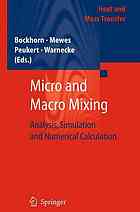

Most ebook files are in PDF format, so you can easily read them using various software such as Foxit Reader or directly on the Google Chrome browser.
Some ebook files are released by publishers in other formats such as .awz, .mobi, .epub, .fb2, etc. You may need to install specific software to read these formats on mobile/PC, such as Calibre.
Please read the tutorial at this link: https://ebookbell.com/faq
We offer FREE conversion to the popular formats you request; however, this may take some time. Therefore, right after payment, please email us, and we will try to provide the service as quickly as possible.
For some exceptional file formats or broken links (if any), please refrain from opening any disputes. Instead, email us first, and we will try to assist within a maximum of 6 hours.
EbookBell Team

4.0
46 reviewsThe homogenization of single phase gases or liquids with chemical reactive components by mixing belongs to one of the oldest basic operations applied in chemical engineering. The design of equipment for mixing processes is still derived from measurements of the mixing time which is related to the applied methods of measurement and the special design of the test equipment itself.
This book was stimulated by the Priority Program on "Flow Mixing" financially supported by the Deutsche Forschungsgemeinschaft (DFG). Results are improved modern methods for experimental research and visualization, for simulations and numerical calculations of mixing and chemical reactions in micro and macro scale of time and local coordinates. The results are aimed to improve the prediction of efficiencies and selectivities of chemical reactions in macroscopic scale. The book should give an understanding of the influence of the construction of different mixing equipment on to the momentum, heat and mass transfer as well as reaction processes running on microscopic scales of time and local coordinates.
Newly developed methods of measurement are adjusted to the scales of the selected special transport and conversion processes. They allow a more detailed modeling of the mixing processes by the formulation of an appropriate set of momentum-, heat- and mass balance equations as well as boundary conditions in time and local coordinates together with constitutive equations and reaction kinetics equations as closure laws for numerical and analytical calculations. The improved and more detailed modeling leads to a major progress in predicting mixing processes on the different scales adjusted to transport and reaction processes in molecular, micro- and macro dimensions.